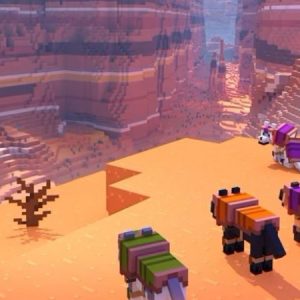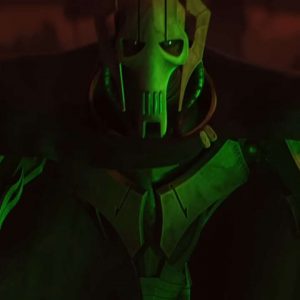Warning: Major spoilers for Stranger Things 3 follow!
Note: Abilities mentioned below are described from the fifth edition of Dungeons & Dragons.
Eleven Is So Wizard
El’s powers may be the result of scientific experiments, but any magic wielder in D&D will recognize the “spell” she uses for most of the season. Scrying is used to see any creature on your plane of existence, and the more familiarity you have with the target of your prying eyes, the better chance you have to succeed. The object of your magical gaze has a chance to become aware of your presence, however, a hard lesson El also learns when Billy stares right back at her.

And, it almost goes without saying, but Telekinesis is another powerful spell in a wizard’s arsenal in D&D that also serves as El’s primary means of attack. El ripping the Mind Flayer’s head down the middle is the kind of impressive feat akin to rolling a Natural 20.

The Party Meets in a Tavern
Scoops Ahoy isn’t just an ice cream parlor in Stranger Things—it’s also where the Scoops Troop begins their epic quest. Like almost all great D&D stories, our heroes gather in the “tavern” and recruit new allies, like the clever and, dare we say, rogue-like Erica Sinclair. She thinks quickly on her feet and looks for ways to get out of tight spots (literally and figuratively), can crack complicated codes, and she’s definitely wily. We’d go on a quest with her anywhere.
For Will the Wise and his party, their inn is Mike’s basement. Instead of ale, they swap stories and gather over Orange Crush and cereal. Truly brave adventurers.
Dungeon Crawl
After the meeting at the tavern usually comes the dungeon crawl, a long trek through a dark cave or maze of rooms deep underground to defeat a monster and find treasure. Along the way the party battle enemies and find valuable items to aid them in their quest. Can you see where we’re going with this? It’s the Scoops Troop who first scouts out the dungeon-like, labyrinthine maze under Starcourt Mall after solving the puzzle to make it inside. They’re successful in their crawl, uncovering the conspiracy that was right beneath their feet–until they roll that natural 1 on stealth and find themselves face to face with an enemy.
Later it’s Joyce Byers, Jim Hopper, and Murray Baumann who start the same dungeon crawl with the help of map that looks like it came straight from the notes of a well-organized Dungeon Master.

Detect Favored Enemy
Will the Wise might be a wizard…

…but the show depicts Will Byers wielding a powerful ability that only rangers receive in D&D. Detect Favored Enemy, when cast, serves as the same sort of warning that Will often feels prickling his skin when the Mind Flayer is near. Rangers get to choose the type of their favored enemy in character creation, but Will had no choice—his enemy picked him.

About That Mind Flayer…
Speaking of the Mind Flayer in Stranger Things, its name is one of the most direct connections to Dungeons & Dragons in the show.

In D&D, mind flayers, also called Illithids, don’t look similar to the towering mass of body parts and goo in Season 3, but there are a few correlations. Mind flayers do have tentacles protruding from their face and nasty psychic powers. These creatures of the Underdark operate in a hive mind, and they’re insidious creatures that consume humanoid brains. Mind flayers communicate through telepathy, and often engage in mind control to combat their enemies—very similar to what we see happen to Billy, Heather, and more of the Flayed when they’re activated and mind-controlled to find more hosts.
Dustin the Bard
When a party is in a pinch, it’s an opportunity for some of the more underrated classes to step up and prove their worth. In Season 3 it was Dustin Henderson who surprised everyone with his dulcet tones, evoking the unassuming yet useful skill set of the Bard class. As the group embarks on their final quest, Dustin Henderson sings a song of inspiration to grant everyone who hears it a boost. It might have been a boost of annoyance in some cases, granted, but it was also definitely a moment of joy and motivation for everyone else listening in—especially all of us in the audience. Oh, and thanks to him and his song, the group solved the final puzzle.
The Satanic Panic Was Real
The epilogue of Season 3 mentions briefly the belief that a “rise in Satanism” is to blame for the strange events in Hawkins, a clear reference to the real Satanic Panic. The Satanic Panic began during the late 1970s. One of the most notorious examples of the moral panic over Satanism is the disappearance of a Michigan teenager in 1979, who was rumored to have run away under the delusion of believing Dungeons & Dragons to be real. The boy was found safe just a few weeks later, but an investigator continued to spout the theory to anyone who would listen that the game was dangerous and inspired violence and delusions. The “panic” and paranoia over Satanism continued well into the 1980s.

The role-playing game survived through it all, reaching its current heyday as a nerd culture phenomenon that brings players together worldwide thanks to online play and livestreams. Now the only panic surrounding Dungeons & Dragons is finding a group to play with.
That’s just the tip of the dungeon of D&D references in Stranger Things. There are also some other small homages, like the disembodied voice proclaiming the dark funhouse at the county fair a “Cave of Horrors,” similar to the classic D&D module “Tomb of Horrors” written by Gary Gygax. There’s also the name of the final episode, “The Battle of Starcourt,” which sounds like a campaign book you’d expect to find on bookshelves filled with tabletop RPGs.
Did you roll high on your perception check to spy even more? Let us know in the comments.
Kelly Knox is a freelance writer who also contributes to StarWars.com, Marvel.com, Nerdist, and more. Follow her on Twitter at @kelly_knox to talk Star Wars, Dungeons & Dragons, comics, and more.






















